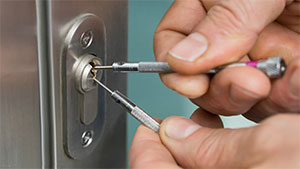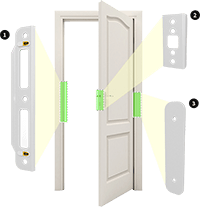
Last month, I completed a lock-picking challenge that involved picking, bypassing, bumping, and shimming various types of locks. For one part of the challenge, I had to pick a door lock, a file cabinet lock, and a tubular lock on a handgun safe in under 3 minutes. Skill-wise, I’m a below average lock picker, and I have historically struggled even worse when under time pressure (the mechanics of picking a tumbler lock involve a lot of tension management, so stress generally increases time required, unless you’re experienced or just a super cool customer). I wasn’t optimistic going into the challenge, especially since the gun safe was an expensive American-made gun safe. Total time to defeat the locks on the door, file cabinet, and gun safe?
55 seconds.
It was an eye-opening experience for me, a very amateur lock picker, to be able to access a loaded firearm that was locked behind three different locks in under a minute. It was a powerful reminder of why you need multiple layers of security if you want to defend your stuff and your person against intruders.
Why have this discussion now? Two reasons, first- violent crime has risen exponentially this year due to a number of factors. Second, because firearm ownership has spiked over the past few months, with record numbers of first-time gun buyers making purchases. While firearms have a lot of advantages (says the competitive shooter/ firearms instructor), they can give you a false sense of security if they are the only part of your security plan. Firearms (and weapons in general) constitute an important layer of a proper security plan, but if they are the only layer you invest in, you are setting yourself up for failure.
If your plan consists of one layer, you are making things too easy for a potential adversary. If your only plan is a firearm, but you don’t have anything to delay or detect an intruder, you are unlikely to be able to access the firearm in time. Conversely, alarms, locks, door braces, safes – everything can be bypassed and defeated if given enough time. The more layers (and variety of layers) you have, the more time you have to react to a breach. The more time you have to react the more options you have at your disposal to respond to an intrusion attempt.

Most security measures fit into at least one of four roles: deter, detect, delay, defeat. Some measures fit into multiple areas, making them solid ways to get a lot of return for your investment. We’ll talk about each area in general below, and then take a look at how to specifically use each area for houses and apartments in the next article.
Deter
What are the two biggest reasons I eat more fast food than I should? Because it’s easy and cheap. It’s so much simpler to go to Culvers and get my $4 butterburger than it is to plan, prepare, and cook a balanced meal of fresh fruit, vegetables, and steak. We humans are wired to want the biggest payoff for the lowest effort.
Potential intruders are making the same decisions when picking people and places to victimize. If a target is attractive and safe, it will be chosen over one that has a lower pay off and higher reward every time. Making our home a less appealing target is one of the best ways we stop intrusion attempts before they even start.
Do you have a dog? Homes with dogs are significantly less likely to get broken into. Do you have a security system sign on your porch? Homes with security systems are 300% less likely to get broken into.
Keeping quiet about a vacation on social media until after you get back, leaving porch lights on (also a method of detection), locking your door (the #1 most common way people break into properties is through open or unlocked doors or windows), breaking down large boxes of expensive electronics before taking them to the curb for recycling- these are all ways to make yourself a less appealing target for potential intruders.
Detect
Detection notifies you that someone is attempting to breach your layers of security. The faster you detect a threat, the more options you have in countering it. If the first time you realize someone is breaking into your house is when you wake up and see a masked intruder rifling through your underwear drawer, your options are fewer than if your motion activated porch light trips and your dog freaks out at the sight of a man with a crowbar on your deck.
Detection also is related to deterrence. Criminals need secrecy to do bad things. They know once they are detected, the clock is running on the authorities (or you) being able to stop their actions. The sooner you detect them, the less time they have to accomplish their intent.
Security systems, dogs, motion lights, cameras, these all fall into detection as well as deterrence and area a great bang for your buck. Your relationship with your neighbors also is a layer of detection as they might see things before you do.
Delay
All security devices (except for weapons) merely buy time. Locks can be bypassed. Windows broken. Safes broken into. Garage doors hacked or (more easily) bypassed by a coat hanger. They are still critical layers of security though, because we need time as defenders. Time works for us- the more time an intruder has to spend bypassing devices, the greater the chance that he triggers one of our detection methods. Once he is detected, delays give the defender time to call for help, fortify their position, and arm themselves with weapons (if they so choose).

Make sure that you have solid delaying measures along the path of least resistance (your main entrances). 57% of intruders don’t “break” anything when they break in, they just enter through an open or unlocked door or window. Only 4% will take time to pick a lock. A burglar is much more likely to damage a door then to pick the lock, making things like door devils a great investment. Garage doors are also a very common method of entry, especially if your vehicle is parked outside it… with the garage door opener in it.
Quality locks, door frame reinforcements, door jams/braces, these things are all critical ways of delaying an intruder and giving you time to respond.
Defeat
All the time in the world won’t do the defender any good if the defender doesn’t have some means to defeat the intruder. The most basic and essential way to do this, both from a tactical and legal perspective, is to call the authorities. The faster the defender can start the clock on having the police show up, the better off they are going to be.
But if I can gain access to a gun that’s behind three layers of locks in under a minute, do we really want to pin all our hopes for defeating an intruder on how quickly police can get to our home? Especially if we live in a rural area or an area where law enforcement is overwhelmed by urban unrest?
Verbal warnings can be a good way of defeating an intruder by deterring them and letting them know you are working against them. Raw data would indicate that if someone breaks into your home, you’re looking at a 60% chance that they are unarmed and not expecting to encounter resistance. Those odds change at night though, when people can be expected to be home. Unsurprisingly, if an intruder is expecting to encounter resistance from a defender, they are significantly more likely to be armed. If you’re home when a burglary takes place, DoJ (Departmnet of Justice) studies show that you’re looking at about a 1 in 4 chance that the intruder will attempt to attack you, and about a 12% chance that your attacker will be armed with a firearm. Do those statistics influence how I plan the defeat layer of my security plan?
You can bet they do.
Know your laws and what your options are, but if you are forced to defend yourself, fight to win. Where you stage your cell phone (to call for help), potential and designed weapons, and how you train to use them are all part of the defeat layer. If you feel that your best option is to leave your home and flee once an intruder is detected, then do what you feel is best, but know that most states do not legally require you to flee if attacked in your home.
A good security plan will be designed with several elements to deter, detect, delay, and defeat an intruder. Next time, we’ll look at some specific recommendations for increasing your security in these four domains and making your living situation significantly more secure.
